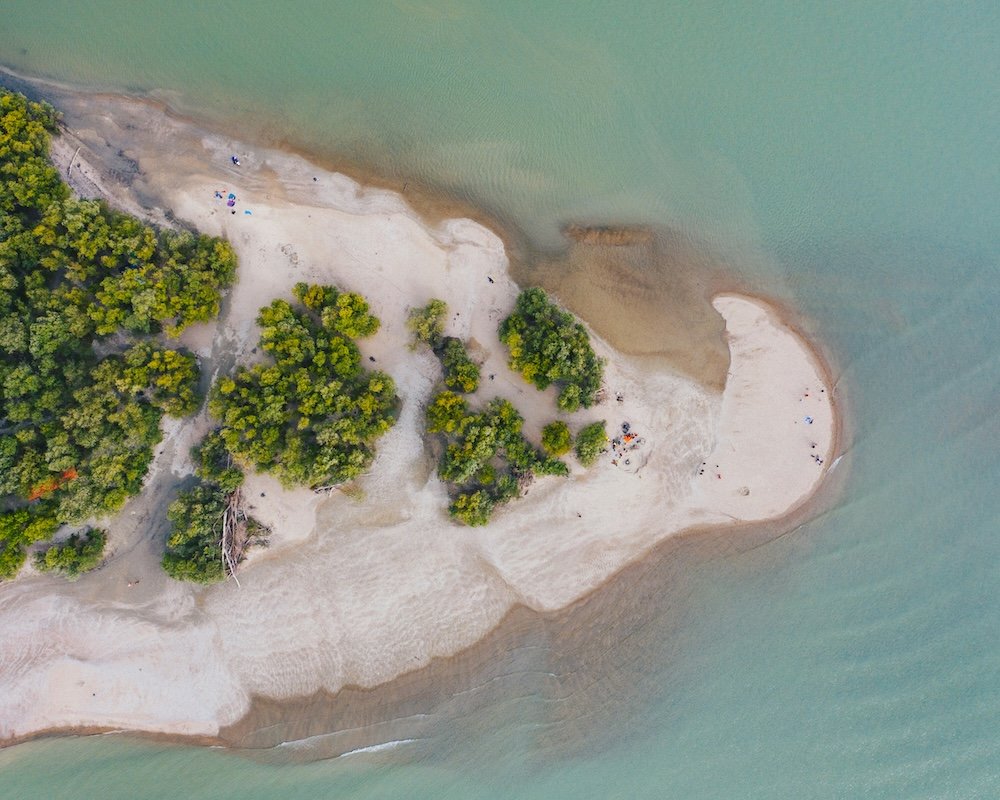
Imagine being marooned on a desert island, much like Robinson Crusoe or the castaways from “Lost”.
This scenario, often dramatized in popular culture, taps into the primal fear and adventurous spirit that lies deep within us all.
Yet, while the idea of surviving on a desert island might seem thrilling in novels and movies, the reality is far more challenging.
In this comprehensive guide, we will delve into the crucial skills and strategies needed to survive and eventually thrive in such an isolated environment.
Our journey through survival on a desert island will cover everything from initial steps after arrival to long-term sustainability strategies.
We will explore how to assess your immediate environment, find water and food, build a shelter, and signal for help.
Additionally, we will discuss maintaining physical and mental health, navigating the terrain, and preparing for the possibility of rescue or indefinite stay.
Plus, don’t miss our bonus section detailing the top 10 essential items you’d want to have if stranded on a desert island.
By the end of this guide, you’ll be equipped with the knowledge to not only survive but to also maintain a level of comfort and security if you ever find yourself stranded on a desert island.
Whether you’re a survival enthusiast, a curious adventurer, or just seeking to be prepared for the unexpected, this article promises to be your ultimate resource.
Now let’s take a closer look at how to survive if you ever get stranded on a desert island:
Understanding Your Environment
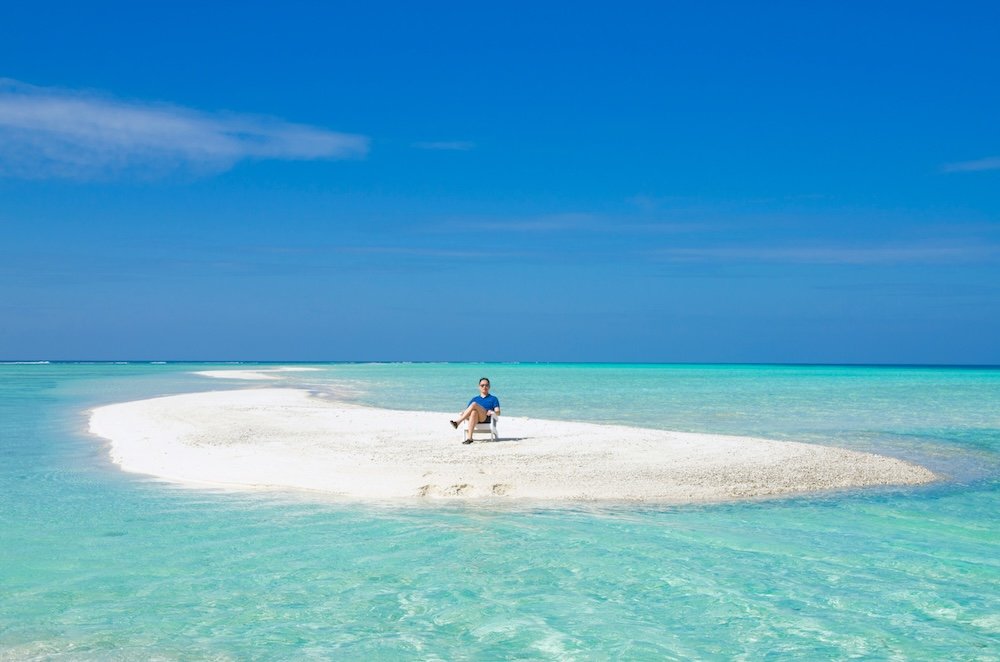
A typical desert island conjures images of sandy beaches, lush palm trees, and crystal-clear waters. However, the reality can vary greatly depending on geographical location.
Most deserted islands feature a tropical or subtropical climate, hosting a diverse range of flora and fauna.
Vegetation can range from dense jungles to sparse shrubbery, with coconut palms often being a common sight.
The animal life might include seabirds, small mammals, and a variety of marine species around the surrounding waters.
Geographical Features Commonly Found on Deserted Islands
Desert islands typically boast a variety of geographical features.
Sandy beaches often border one side, while rocky cliffs or dense forests may dominate the landscape elsewhere.
Freshwater sources such as streams or springs are crucial but not always available, necessitating other means of water collection.
Coral reefs might surround the island, offering both an abundant food source and a potential hazard due to their barrier to navigation and ship approach.
Challenges and Resources Typically Available
Living on a desert island presents numerous challenges.
Freshwater scarcity is often the most pressing issue, followed by the need for adequate shelter and sustainable food sources.
Weather conditions such as tropical storms can also pose severe threats to safety and survival.
On the resource side, islands may provide plentiful materials for shelter building and basic tools, such as bamboo, vines for rope, and wood.
Edible plants and the possibility of fishing provide nutritional options but require knowledge and skills to exploit safely and effectively.
By familiarizing yourself with the environment of a desert island, you can better prepare to utilize its resources and overcome its challenges.
This knowledge is not just crucial for survival but also for maintaining health and morale during your stay on the island.
Immediate Steps Upon Arrival
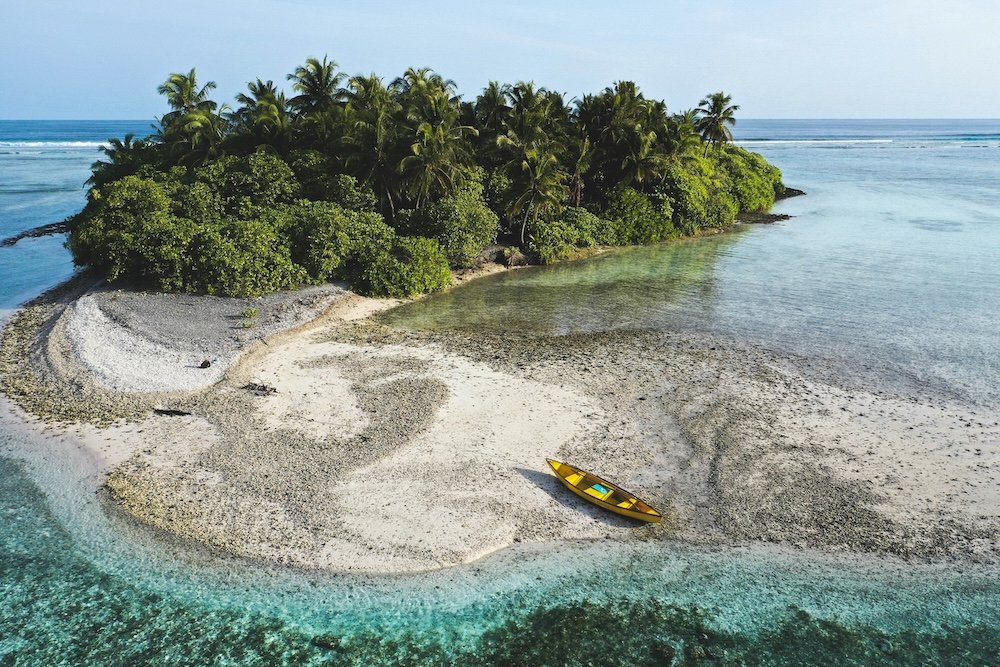
Assessing Your Situation
Upon arriving on a desert island, your first priority should be to assess your immediate situation.
Evaluate your safety—check for any injuries and ensure that you are out of harm’s way from natural hazards such as wildlife or unstable terrain.
Understanding your health status and any immediate threats is crucial before you proceed with other survival tasks.
Importance of Finding a Safe Shelter
Finding a safe shelter should be your next step.
A good shelter protects you from the elements and can greatly improve your psychological well-being.
Look for natural shelters like caves or overhanging cliffs, or prepare to build one if none are available.
The ideal location is elevated to avoid tidal surges and close enough to a freshwater source.
Your shelter should also be visible enough to aid potential rescuers but camouflaged enough to keep you safe from animals.
How to Check for and Secure a Fresh Water Source
Securing a fresh water source is vital.
Begin by scouting for streams, rivers, or lakes.
If no obvious water sources are present, collect dew or rainwater using leaves, tarps, or any plastic sheets you might have.
Check the water clarity and smell; avoid water that has a strong odor or is stagnant.
Boiling water is the best way to ensure its safety, but if you can’t make fire, consider other purification methods like solar stills or water purification tablets if available.
Initial Foraging for Food: What’s Safe to Eat and What’s Not
When it comes to food, proceed with caution.
Your initial foraging efforts should focus on well-known safe foods such as coconuts and other tropical fruits.
Avoid eating any plants, fruits, or mushrooms unless you are certain they are non-toxic—many islands may host seemingly edible but actually poisonous species.
Learning beforehand about the local flora can be lifesaving. Fishing can also provide a reliable food source if you have the means to catch and cook fish.
Building a Shelter
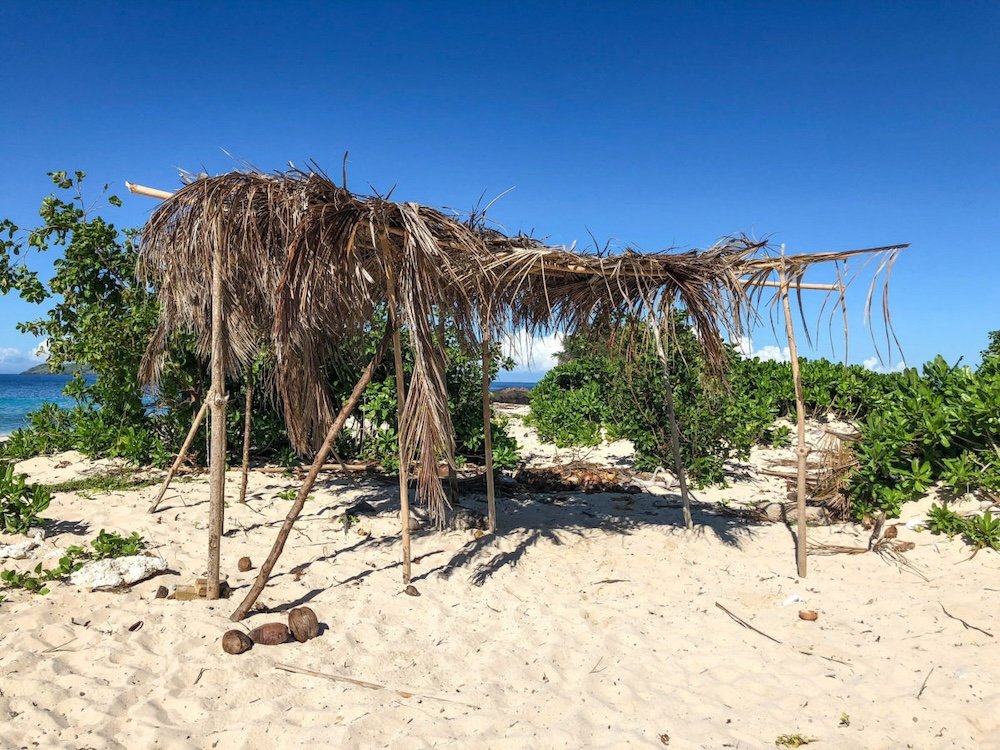
Types of Shelters Suitable for a Deserted Island Environment
When building a shelter on a deserted island, the type you choose depends heavily on the available materials and environmental conditions. The most common types are:
- Lean-to Shelter: Easy to construct with branches and foliage, this shelter is effective against wind and sun. Position it to face away from prevailing winds.
- A-Frame Shelter: Using more materials than a lean-to, the A-frame offers better protection from rain and can be insulated with leaves and grass.
- Teepee Shelter: Ideal if you have access to longer poles. A teepee provides excellent drainage in rainy conditions and can be easily sealed off for warmth.
Materials Available and How to Use Them
Materials for shelter construction on a desert island typically include:
- Bamboo and Wood: Strong and versatile for framing structures.
- Palm Fronds: Ideal for roofing material as they are large, waterproof, and durable.
- Vines and Seaweed: Can be used for tying materials together in lieu of rope.
- Large Leaves and Grass: Useful for insulation and additional waterproofing.
Start by creating a frame from bamboo or wood, securing it with vines or seaweed. Cover this framework with palm fronds, starting from the bottom and working your way up to overlap like shingles, ensuring water runs off effectively.
Tips for Making Your Shelter Comfortable and Secure
To maximize comfort and safety in your shelter, consider the following tips:
- Location: Choose a location that is dry, flat, and safe from high tides and falling branches. Proximity to a water source is a plus, but avoid areas that might be prone to flooding.
- Insulation: Line the floor with dried leaves or grass to provide insulation from the cold ground. Additional layers can be added to the walls for warmth.
- Ventilation: Ensure your shelter has sufficient ventilation to prevent condensation and provide airflow, which is especially important in hot and humid climates.
- Regular Maintenance: Check and maintain your shelter regularly to repair any damage and reinforce its structure, ensuring it remains robust against weather conditions.
Building an effective shelter is crucial for protection against the elements and for psychological comfort, which can greatly enhance your chances of survival and overall well-being while stranded on a desert island.
Finding and Purifying Water
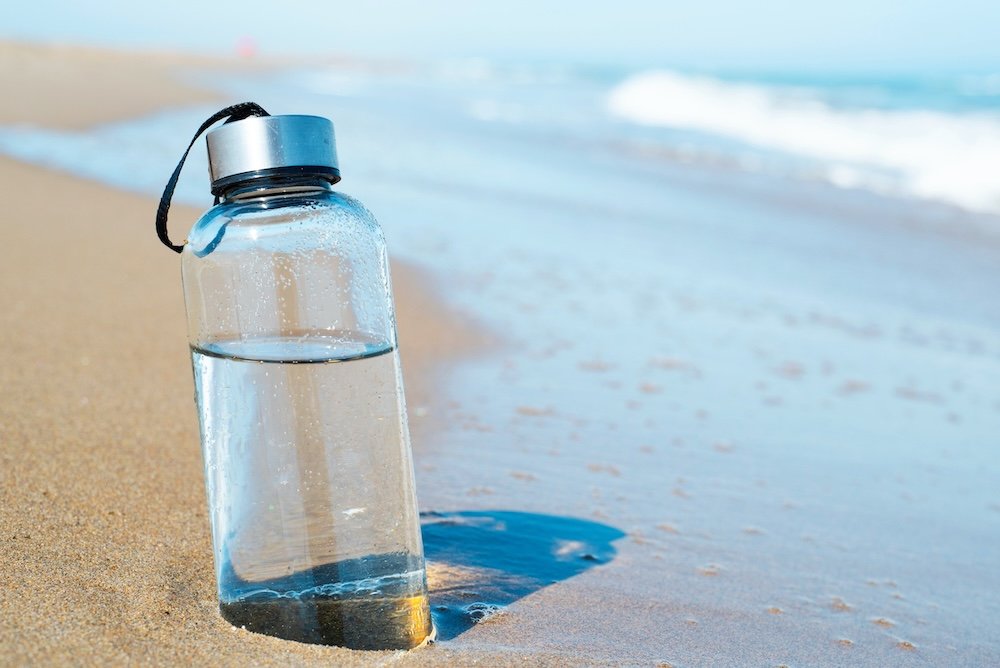
Methods to Find Fresh Water Sources
Finding fresh water is a critical survival skill on a deserted island. Here are some methods to locate water sources:
- Surface Water: Look for streams, rivers, or lakes. Even small puddles of rainwater can be collected and purified.
- Rainwater: Set up a collection system using large leaves, tarps, or any clean, non-absorbent materials to catch and funnel rain into a container.
- Natural Wells: Sometimes, digging in a damp area can yield a small well of fresh water. Look for areas where vegetation is denser and the ground feels moist underfoot.
- Condensation Traps: In the absence of visible water sources, create condensation traps or solar stills to collect water from the soil and vegetation.
Techniques to Purify and Store Water
Once you have located a water source, purification is essential to make it safe for drinking. Here are some effective methods:
- Boiling: The most reliable method to purify water. Boil water for at least one minute to kill harmful organisms. If you’re at higher elevations, increase this time to three minutes.
- Solar Water Disinfection (SODIS): Fill clear plastic bottles with water and place them under the sun for a minimum of six hours. The UV rays will help kill pathogens, making the water safer to drink.
- Natural Filtration: Use materials like sand, charcoal, and gravel to create a simple filter. Layers of these materials can help remove particles and some pathogens from water before boiling or applying other purification methods.
Storing Water Safely
After purification, storing water safely is crucial to ensure it remains drinkable:
- Clean Containers: Always use clean containers to store water. Contaminated containers can quickly undo all your hard work in purification.
- Keep It Covered: Store water in a cool, shaded place, away from direct sunlight and properly covered to prevent recontamination.
- Regular Rotation: Use stored water regularly and replenish with freshly purified water to keep the supply safe and fresh.
Securing a reliable water source and ensuring its purity can significantly increase your chances of survival on a deserted island.
These techniques not only make water safe to drink but also help in managing a sustainable living condition while awaiting rescue.
Foraging and Fishing for Food

Safe Practices for Identifying Edible Plants and Fruits
Foraging for plant-based food on a deserted island requires knowledge and caution. Here are key guidelines to ensure safety:
- Avoid Unknown Plants: Never eat any part of a plant unless you are certain of its identity and know it’s safe to eat.
- Use Reference Guides: If possible, carry a guidebook or have knowledge of local plant life, focusing on common edible and medicinal plants.
- Test Method: If identification is uncertain, use the universal edibility test, which involves exposing small portions of the plant to your skin, then lips, and finally your tongue, waiting for adverse reactions at each stage before consuming.
Techniques for Fishing and Trapping Small Animals
Protein is crucial for survival, and seafood or small game can be excellent sources:
- Fishing: Use makeshift fishing gear like spears, nets, or improvised fishing rods. Bait can be gleaned from insects or small bits of food.
- Traps and Snares: Set up simple traps or snares in pathways or near burrows where small animals are likely to travel. Be sure to check these regularly.
- Spearfishing: If the water is clear and shallow, spearfishing can be a viable option. It requires patience and practice but can be highly effective.
Sustainable Practices to Ensure Long-Term Nourishment
Maintaining a sustainable approach to food sources is crucial for long-term survival:
- Rotate Foraging Areas: Avoid overharvesting any single area to allow plant populations to recover.
- Selective Fishing and Hunting: Target abundant species and mature individuals to help preserve populations.
- Seed Saving and Planting: Consider saving seeds from edible fruits and vegetables for planting. This can help in creating a more permanent food source over time.
By following these practices, you can secure a varied and reliable food supply, crucial for maintaining strength and health on a deserted island.
These methods not only support immediate survival but also contribute to a sustainable living situation should your stay become prolonged.
Signaling for Help
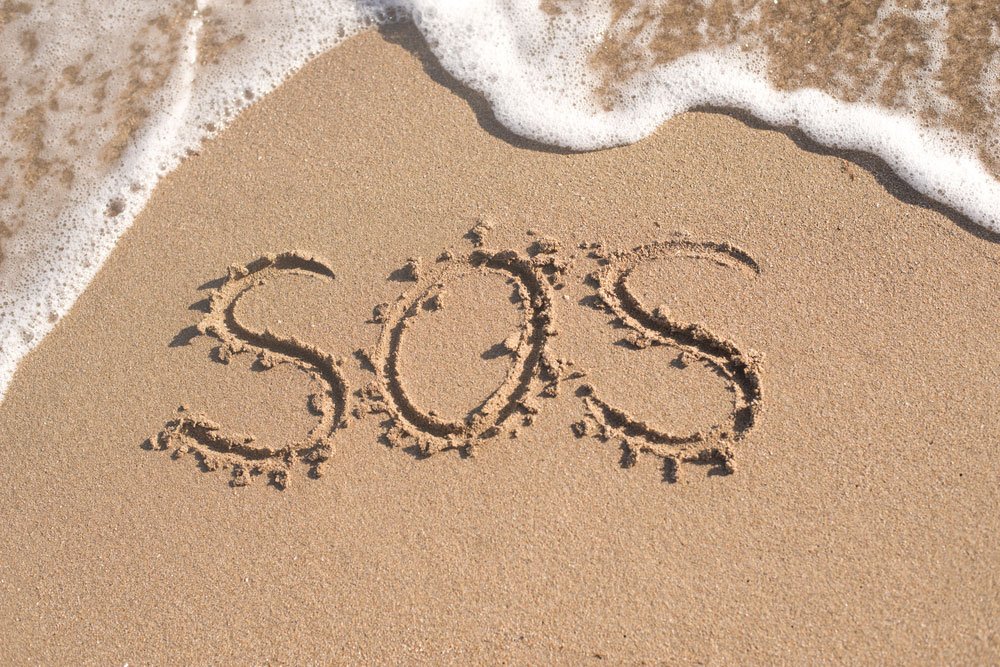
Creating Effective Signals Using Natural Resources
Being visible is key to being rescued from a deserted island.
Here are some methods to create effective signals using what you find around you:
- Ground Signals: Use rocks, logs, or even sand to create large SOS or HELP signs on the ground, visible from the air. Position these in clearings or on beaches where they are most likely to be seen.
- Fire and Smoke: Maintain a ready supply of green foliage and dry wood to create smoke during the day. Smoke is highly visible from the air and can be seen from great distances over water.
Best Practices for Using Flares, Mirrors, or Smoke
If you have access to man-made tools, they can significantly increase your chances of rescue:
- Flares: Use flares only when you are sure rescuers are within sight. Flares have a limited burn time, so timing is crucial.
- Mirrors: A mirror or any reflective surface can be used to flash sunlight towards a plane, helicopter, or distant ship. Practice aiming the reflection to make sure it is noticed.
- Smoke: In addition to natural smoke signals, if you have materials like rubber or oil, they can produce thick, black smoke that stands out against a bright sky or at dusk.
Timing Your Signals for Maximum Visibility
The timing of your signals can make the difference between being seen or missed:
- Daytime: During the day, smoke signals are the most effective. Keep fires small but ready to produce a lot of smoke quickly when you spot a potential rescuer.
- Clear Weather: Signal during clear weather conditions to ensure maximum visibility. Poor weather can obscure flares, mirrors, and smoke, reducing their effectiveness.
- Routine Signaling: Establish a routine for signaling at specific times of the day to conserve resources while ensuring that you’re actively trying to be rescued.
By understanding and implementing these signaling techniques, you can increase your visibility and improve your chances of being rescued from a deserted island.
Each method should be used thoughtfully and conservatively to make the most of your resources until help arrives.
Navigating the Island
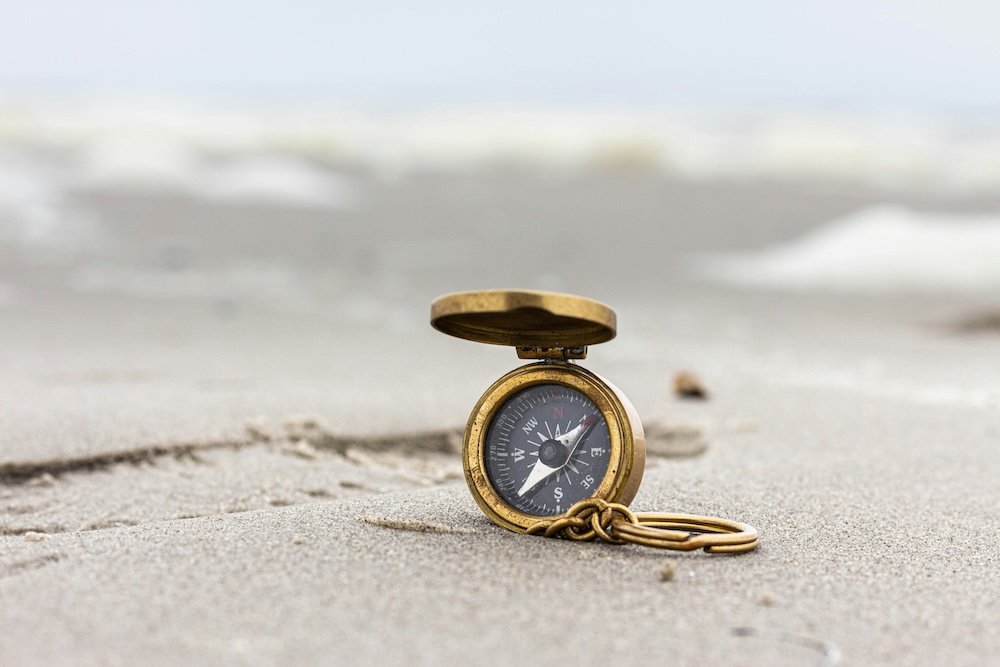
Basics of Orientation and Mapping Your Surroundings
Navigating effectively on a deserted island begins with understanding your environment and orienting yourself within it. Here’s how you can start:
- Use Natural Landmarks: Identify natural landmarks such as large trees, rock formations, or coastline features to help you establish directions and points of reference.
- Create a Basic Map: As you explore, sketch a rudimentary map, noting key features and water sources. This can help in planning your movements and ensuring you can always find your way back to camp.
- Sun and Stars: Familiarize yourself with basic celestial navigation techniques. The sun rises in the east and sets in the west, which can aid in general orientation. At night, locating the North Star (Polaris) in the Northern Hemisphere or the Southern Cross in the Southern Hemisphere can provide directional guidance.
Techniques for Moving Around the Island Safely
Moving safely around the island requires caution and preparation:
- Stay Visible: Wear bright colors or materials that stand out against the natural background to increase your visibility.
- Watch Your Step: Be mindful of the terrain. Avoid areas that look unstable, such as loose rocks or slippery mud slopes.
- Carry Essentials: Always bring water, a basic first aid kit, and a whistle or another signaling device when exploring. This ensures you can hydrate, manage minor injuries, or signal for help if necessary.
Importance of Marking Your Trail
As you navigate the island, marking your trail is vital for several reasons:
- Prevent Getting Lost: Use natural materials to mark your path without harming the environment. Stacking stones, tying knots in branches, or creating small notches in trees can help you find your way back.
- Communication: Trail markers can also communicate your presence and direction to any other survivors or rescuers.
- Efficiency: Marking your trail helps in retracing your steps quickly and efficiently, saving energy and reducing the risk of unnecessary exposure to hazards.
By mastering these navigation techniques, you can ensure that you not only explore the deserted island safely but also maximize your chances of survival by effectively managing your movements and maintaining awareness of your surroundings.
Maintaining Health and Wellness

Mental Health Tips to Cope with Isolation and Stress
Surviving on a deserted island can be as much a mental challenge as a physical one. Here are some strategies to help manage mental health:
- Establish Routines: Create a daily schedule to provide structure and a sense of normalcy.
- Stay Active: Engage in physical activity not only for survival tasks but also as a way to boost mood and reduce anxiety.
- Keep a Journal: Documenting your thoughts and experiences can be a therapeutic outlet and help manage feelings of isolation.
- Focus on Positive Outcomes: Visualization techniques and maintaining hope can have a significant psychological benefit.
Basic First Aid Tips and Dealing with Common Ailments
Knowing how to treat common ailments and injuries is crucial for long-term survival:
- Cuts and Scrapes: Clean wounds with fresh water and apply a bandage. For deeper cuts, apply pressure to stop bleeding and secure the wound.
- Sunburn: Avoid excessive sun exposure by wearing protective clothing or staying in the shade during peak hours. Use aloe vera or other soothing agents if available.
- Dehydration: Always prioritize water consumption. Recognize signs of dehydration (thirst, dry mouth, fatigue) early and act quickly.
- Insect Bites: Protect yourself from insects using natural repellents like smoke or plant oils. Treat bites with soothing mud or plant sap to reduce irritation.
Importance of Physical Routine to Maintain Strength and Morale
Regular physical activity is essential not only for survival but for maintaining overall health:
- Exercise Regularly: Simple exercises like walking, stretching, or any form of calisthenics can help maintain muscle tone and cardiovascular health.
- Incorporate Work and Play: Balance physically demanding tasks like building or foraging with lighter, enjoyable activities such as swimming or exploring.
- Engage in Resilience Building: Activities that build physical and mental resilience can improve your ability to cope with the stresses of island life.
Maintaining health and wellness on a deserted island involves a holistic approach that includes taking care of your body, mind, and emotional well-being.
By adopting these practices, you can significantly enhance your quality of life and increase your chances of survival and rescue.
Preparation for Rescue
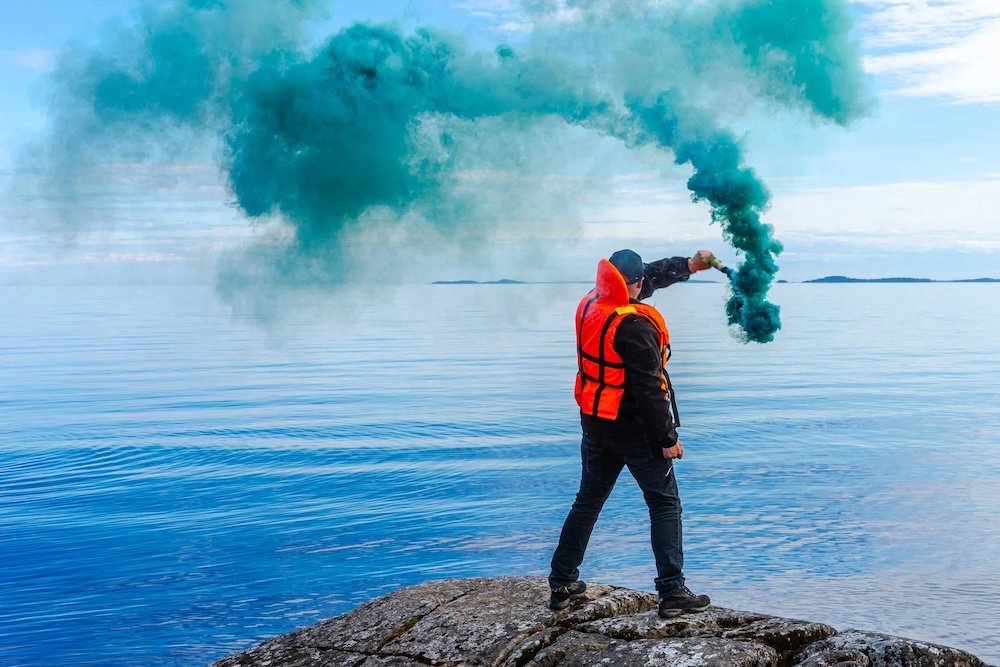
Preparing a Survival Kit in Anticipation of Rescue Opportunities
Being ready for rescue means having a survival kit that is accessible and equipped with essential items to signal and sustain yourself in the moment of rescue. Your survival kit should include:
- Signal Devices: Flares, mirrors, and whistles to alert rescuers to your presence.
- Essential Documents: Identification, any medical records, and emergency contact information in a waterproof container.
- Survival Gear: A flashlight, extra batteries, a multi-tool, and a small amount of non-perishable food.
- Personal Protection: Additional layers of clothing or a blanket to keep warm during rescue operations, especially if rescue might occur during cooler times of day or night.
Steps to Take When You Hear a Rescue Team or See a Ship
The moment you believe rescue is imminent requires calm, calculated actions:
- Use Your Signals: Immediately use your most effective signaling method. If it’s daylight, use mirrors to reflect sunlight; at night, use flares or fires.
- Stay Visible: Position yourself in an open area, preferably where you’ve prepared large ground signals or where you are most visible.
- Continue to Signal: Keep signaling until you are absolutely certain that rescuers have seen you and are on their way.
How to Interact and Communicate Effectively with Rescuers
Once rescuers arrive, it’s important to communicate effectively:
- Remain Calm and Follow Instructions: Show that you are calm and ready to cooperate. This helps rescuers do their job more effectively.
- Provide Essential Information: Be ready to provide information about your health, duration of stay, and any other survivors.
- Express Gratitude: Rescuers are often risking their own lives to help. A simple thank you can go a long way in acknowledging their efforts.
Preparation for rescue on a deserted island involves not only readiness with physical items but also mental preparation to handle the rescue situation effectively.
By staying prepared and informed, you improve your chances of a successful and swift rescue.
Long-term Survival Strategies

Establishing a Routine to Maintain a Sense of Normalcy
When faced with the possibility of an extended stay on a deserted island, establishing a daily routine is crucial. This helps to maintain a sense of normalcy and mental stability:
- Create a Schedule: Divide your day into periods for specific activities like gathering food, maintaining shelter, exploring, and leisure time.
- Include Regular Meals and Sleep Cycles: Eating at regular times and maintaining a consistent sleep schedule can greatly improve both your physical health and emotional well-being.
- Set Goals: Weekly or monthly goals can give you something to strive for, keeping your motivation high.
Strategies for Improving Your Living Conditions Over Time
As time passes, you can take steps to improve your living conditions, which will make your life on the island more bearable:
- Upgrade Your Shelter: Continuously improve your shelter’s comfort and resilience against weather changes. This may include reinforcing the structure or creating better insulation.
- Develop a Food Supply: Start a basic garden if the climate and soil permit. Cultivating plants not only provides a sustainable food source but can also lead to improved nutrition.
- Innovate and Repurpose: Use any washed-up materials or remnants from your initial survival kit to create tools, cooking instruments, or other useful items.
Planning for the Possibility of Living Indefinitely on the Island
While rescue should always be a hope, preparing for long-term or indefinite survival is a practical approach:
- Learn Advanced Skills: Teach yourself more complex survival skills such as advanced fishing techniques, food preservation, and perhaps even building a more permanent home.
- Keep a Log: Documenting everything from weather patterns to your daily activities can help in managing your resources more effectively and can serve as a crucial tool for planning.
- Maintain Physical and Mental Health: Engage in regular physical exercise and find ways to keep your mind active, whether it’s crafting, reading if you have books, or even writing.
By embracing these long-term survival strategies, you can enhance your ability to live sustainably on a deserted island, improving your quality of life and keeping yourself prepared for either eventual rescue or a prolonged stay.
Top 10 Essential Items to Have on a Deserted Island
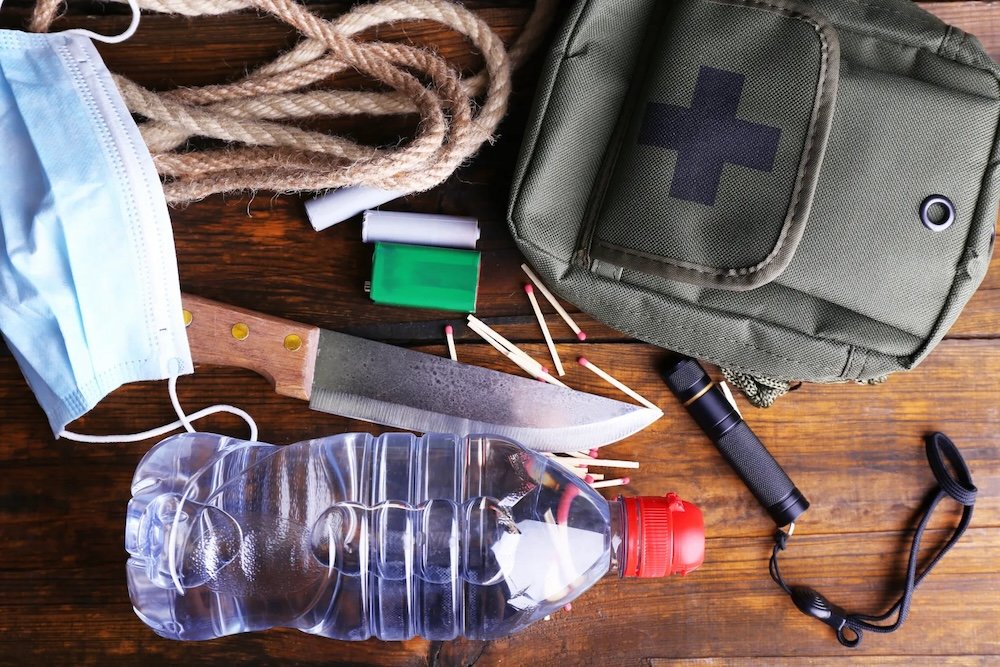
When planning for survival on a deserted island, certain items are indispensable for ensuring your safety, health, and a higher chance of rescue. Here are the top 10 essential items to have:
- Multi-tool: A good multi-tool is invaluable for building, repairing, and performing a multitude of tasks around your shelter and for daily survival.
- Water Purification Supplies: Include water purification tablets, portable filters, or equipment necessary for boiling water to ensure all drinking water is safe from pathogens.
- Emergency Shelter: A compact, easy-to-set-up emergency shelter can save time and energy and provide immediate protection from the elements.
- Fire Starting Kit: Waterproof matches, lighters, and fire starters are crucial for cooking food, boiling water, and staying warm. Ensure they’re kept in a waterproof container.
- First Aid Kit: Essential for treating injuries and preventing infections, a well-stocked first aid kit can be a lifesaver, containing items such as bandages, antiseptic wipes, and antibiotics.
- Durable Clothing and Rain Gear: Protect yourself from the elements with durable clothing. Include rain gear to stay dry and maintain body temperature in wet conditions.
- Fishing Gear and Hunting Tools: Compact fishing rods, nets, or simple traps can provide a reliable food source from the surrounding waters or wildlife.
- Signaling Device: A mirror to signal aircraft during the day, a whistle for close range, and a flare gun for attracting attention from distant rescuers are critical.
- Portable Solar Charger and Radio: Keeping a radio can help you stay updated on weather conditions and potential rescue operations. A portable solar charger ensures your electronic devices remain powered.
- Nutrition Bars and Emergency Food Supplies: Stock up on high-calorie, non-perishable food items that require minimal preparation to maintain your energy levels until you can establish a more reliable food source.
Having these essential items can significantly increase your comfort, survival chances, and ability to signal for help effectively while stranded on a deserted island.
Conclusion
In this comprehensive guide, we’ve explored the vital strategies and skills necessary to survive on a deserted island.
From the initial steps of assessing your environment, finding and purifying water, and building a shelter, to more advanced techniques like foraging, fishing, and signaling for rescue.
We’ve also discussed maintaining your health and wellness, navigating the island safely, and preparing for long-term survival, should your stay become prolonged.
Surviving on a deserted island is not only about managing your physical needs—it’s also a profound test of mental strength and resilience.
The capacity to endure and adapt to such extreme conditions showcases the incredible potential of human determination and ingenuity.
If this guide has sparked your interest or inspired you to ensure you are prepared for any situation, consider taking a step further.
Learning more about survival skills through books, online resources, or hands-on training can be incredibly rewarding.
Participating in a survival training course can provide not only the skills but also the confidence to handle unexpected challenges.
Remember, while the scenario of being stranded on a deserted island might seem unlikely, the principles and skills you’ve learned here are applicable in many less extreme situations you might encounter.
Be prepared, stay informed, and above all, believe in your ability to overcome.
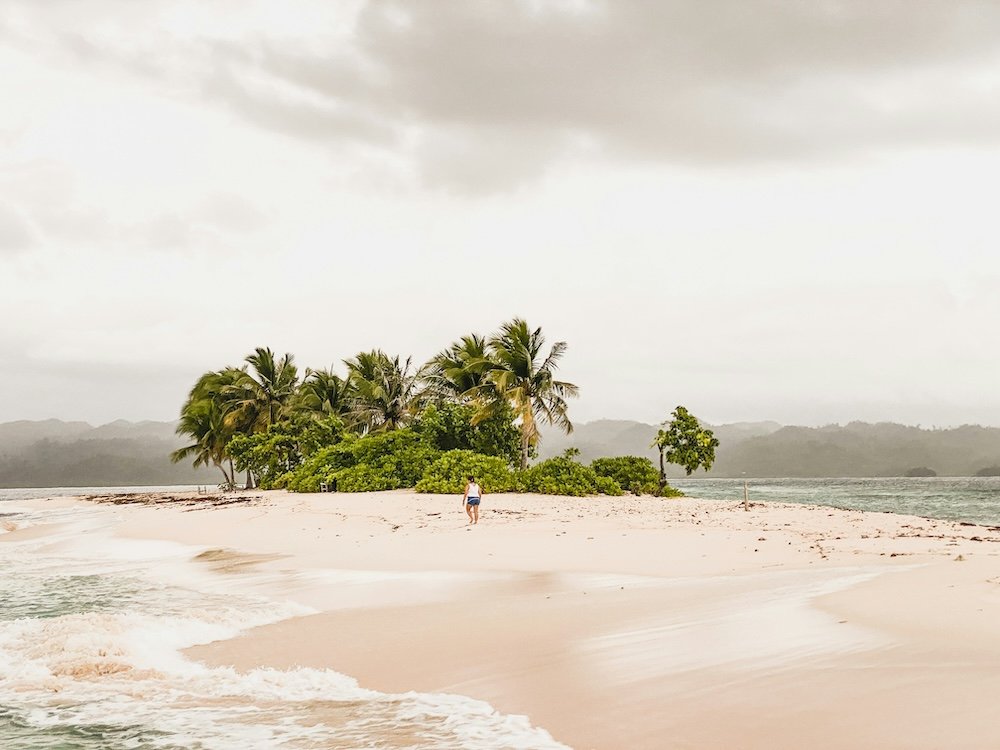
FAQ’s About Being Stranded on a Deserted Island:
How can I determine if plants are safe to eat on a deserted island?
To determine if plants are safe to eat, use the Universal Edibility Test.
This involves separating the plant into its basic components—leaves, stems, and roots—and testing each part separately for adverse reactions.
Avoid any plants that have milky sap, a bitter taste, or an almond smell, as these traits often indicate toxicity.
What are the first things I should do when I find myself stranded on a deserted island?
When stranded, first ensure your immediate safety from potential hazards.
Next, find a source of fresh water. Then, seek or build a shelter before nightfall.
Finally, signal for help using available resources and start planning for food through foraging or fishing.
How can I create fire without matches or a lighter?
Creating fire without matches or a lighter can be achieved by using a friction-based method such as the bow drill technique.
You’ll need some dry wood, a shoelace or string, and a lot of persistence.
Another method is using a magnifying glass or any convex lens to focus sunlight onto tinder during sunny conditions.
How often should I signal for rescue?
Signal for rescue as frequently as your resources allow, especially when conditions are optimal (clear skies and daylight).
If you have a limited number of flares or other one-time-use signals, reserve them for times when you hear or see potential rescuers nearby.
Is it possible to survive indefinitely on a deserted island?
Surviving indefinitely on a deserted island is challenging but possible, depending on the resources available.
Long-term survival would require securing a reliable water source, effective food strategies like foraging, fishing, and possibly cultivating plants, as well as maintaining shelter and health.
